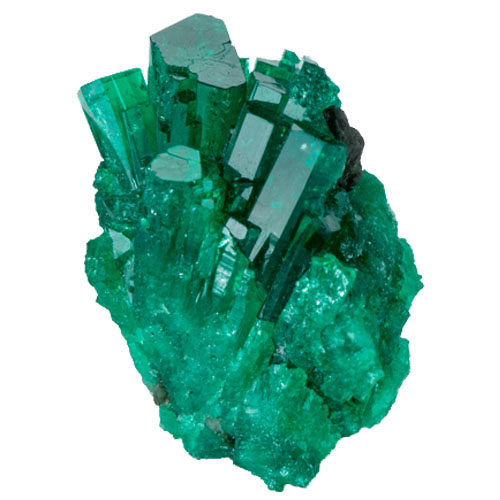Where in the world do emeralds come from? One of the most noteworthy sources for this green precious gemstone is Columbia, which has produced some of the world’s finest emeralds for the last 500 years. Another source for fine quality emeralds is Brazil, where the presence of emeralds has been a rather recent discovery. These gems can also be found in Zambia and Afghanistan.
How are emeralds formed? Emeralds are a variety of the mineral beryl, which is composed of beryllium, aluminum, silicon and oxygen. To form, an emerald needs both water and heat, in addition to the right chemical structure. When magma is brought to the earth’s surface by volcanic eruption, an igneous rock called pegmatite can be formed. As the magma solidifies, water occasionally gets trapped within the cavities and overtime, these cavities crystallize and eventually become pegmatite. When the mineral beryl occurs in these rocks, emeralds can form.
Where does an emerald’s color come from? An emerald’s green color comes from trace amounts of chromium, vanadium, and iron found in the gemstone. The presence or absence of these three minerals, along with their amounts, will determine the exact color of the emerald.
What determines the value of an emerald? Like other gemstones, an emerald’s value depends on its color, cut, clarity, and carat weight. The most valuable emeralds are bluish green to pure green with vivid color saturation. These emeralds will feature a color that is evenly distributed throughout the gemstone. The one downside to emeralds is that the majority of these gems contain inclusions that are visible to the naked eye. These inclusions can affect the appearance as well as durability of the gemstone. Emeralds that are free of inclusions are very rare, and thus extremely valuable. In regards to cut, the most valuable emeralds are the ones with a cut that minimizes any possible fractures, makes the gemstone less vulnerable to chipping or damage, and maximizes the emerald’s color. As is the case with other precious gemstones, typically the larger emeralds will be the most valuable when comparing two otherwise similar quality gems. Emeralds over 2 carats are very rare, and thus command a higher price.
How do emeralds compare in value to sapphires or rubies? It all depends on the quality and size of the gemstones, but generally with larger, high quality gemstones; emeralds will be slightly less expensive than rubies and a bit more expensive than sapphires.
Do emeralds symbolize anything? Emeralds are the birthstone for May as well as the designated gemstone for the 20th and 35th wedding anniversaries. They are believed to improve memory, increase eloquence, and quicken intelligence.
Can emerald jewelry be worn every day? On the Mohs scale of mineral hardness, emeralds come in between 7.5 and 8, which means they require more care than other more durable gemstones, such as diamonds, sapphires, or rubies. This doesn’t mean you can’t wear your emerald jewelry every day, it just means that you need to be very careful if you do, especially if it’s an emerald ring. Because of their many inclusions, you need to make sure to avoid accidentally bumping your emerald jewelry into any hard objects. Doing so will likely chip or damage the gemstone. We recommend that if you want to wear your emerald jewelry regularly, you have the gemstone placed in a secure setting.
How should I care for my emerald jewelry? In addition to making sure you avoid accidentally hitting your emerald jewelry against hard objects, you should also make sure to avoid contact with any harsh chemicals. When at home, take your emerald jewelry off and store in a safe place. Also make sure to avoid wearing or storing your emerald jewelry in any hot environment. To clean your emerald jewelry, use warm water and a soft brush or soft damp cloth.
View Kloiber Jewelers’ emerald jewelry collection here.


